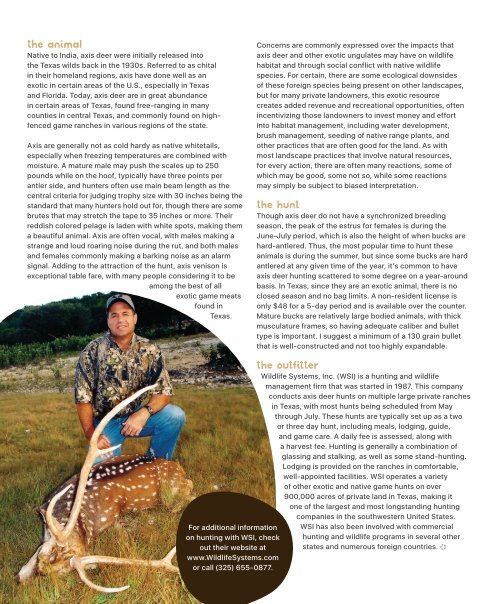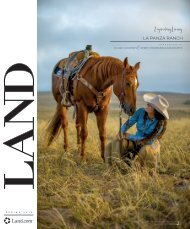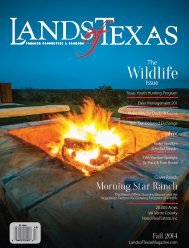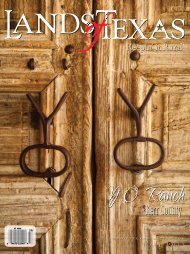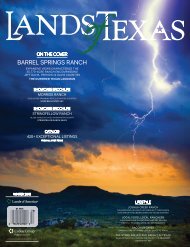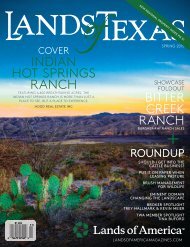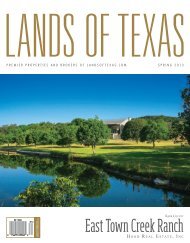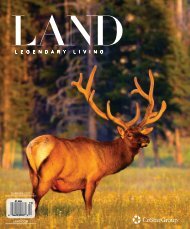You also want an ePaper? Increase the reach of your titles
YUMPU automatically turns print PDFs into web optimized ePapers that Google loves.
the animal<br />
Native to India, axis deer were initially released into<br />
the Texas wilds back in the 1930s. Referred to as chital<br />
in their homeland regions, axis have done well as an<br />
exotic in certain areas of the U.S., especially in Texas<br />
and Florida. Today, axis deer are in great abundance<br />
in certain areas of Texas, found free-ranging in many<br />
counties in central Texas, and commonly found on highfenced<br />
game ranches in various regions of the state.<br />
Axis are generally not as cold hardy as native whitetails,<br />
especially when freezing temperatures are combined with<br />
moisture. A mature male may push the scales up to 250<br />
pounds while on the hoof, typically have three points per<br />
antler side, and hunters often use main beam length as the<br />
central criteria for judging trophy size with 30 inches being the<br />
standard that many hunters hold out for, though there are some<br />
brutes that may stretch the tape to 35 inches or more. Their<br />
reddish colored pelage is laden with white spots, making them<br />
a beautiful animal. Axis are often vocal, with males making a<br />
strange and loud roaring noise during the rut, and both males<br />
and females commonly making a barking noise as an alarm<br />
signal. Adding to the attraction of the hunt, axis venison is<br />
exceptional table fare, with many people considering it to be<br />
among the best of all<br />
exotic game meats<br />
found in<br />
Texas.<br />
Concerns are commonly expressed over the impacts that<br />
axis deer and other exotic ungulates may have on wildlife<br />
habitat and through social conflict with native wildlife<br />
species. For certain, there are some ecological downsides<br />
of these foreign species being present on other landscapes,<br />
but for many private landowners, this exotic resource<br />
creates added revenue and recreational opportunities, often<br />
incentivizing those landowners to invest money and effort<br />
into habitat management, including water development,<br />
brush management, seeding of native range plants, and<br />
other practices that are often good for the land. As with<br />
most landscape practices that involve natural resources,<br />
for every action, there are often many reactions, some of<br />
which may be good, some not so, while some reactions<br />
may simply be subject to biased interpretation.<br />
the hunt<br />
Though axis deer do not have a synchronized breeding<br />
season, the peak of the estrus for females is during the<br />
June–July period, which is also the height of when bucks are<br />
hard-antlered. Thus, the most popular time to hunt these<br />
animals is during the summer, but since some bucks are hard<br />
antlered at any given time of the year, it’s common to have<br />
axis deer hunting scattered to some degree on a year-around<br />
basis. In Texas, since they are an exotic animal, there is no<br />
closed season and no bag limits. A non-resident license is<br />
only $48 for a 5-day period and is available over the counter.<br />
Mature bucks are relatively large bodied animals, with thick<br />
musculature frames, so having adequate caliber and bullet<br />
type is important. I suggest a minimum of a 130 grain bullet<br />
that is well-constructed and not too highly expandable.<br />
For additional information<br />
on hunting with WSI, check<br />
out their website at<br />
www.WildlifeSystems.com<br />
or call (325) 655-0877.<br />
the outfitter<br />
Wildlife Systems, Inc. (WSI) is a hunting and wildlife<br />
management firm that was started in 1987. This company<br />
conducts axis deer hunts on multiple large private ranches<br />
in Texas, with most hunts being scheduled from May<br />
through July. These hunts are typically set up as a two<br />
or three day hunt, including meals, lodging, guide,<br />
and game care. A daily fee is assessed, along with<br />
a harvest fee. Hunting is generally a combination of<br />
glassing and stalking, as well as some stand-hunting.<br />
Lodging is provided on the ranches in comfortable,<br />
well-appointed facilities. WSI operates a variety<br />
of other exotic and native game hunts on over<br />
900,000 acres of private land in Texas, making it<br />
one of the largest and most longstanding hunting<br />
companies in the southwestern United States.<br />
WSI has also been involved with commercial<br />
hunting and wildlife programs in several other<br />
states and numerous foreign countries. °<br />
114


